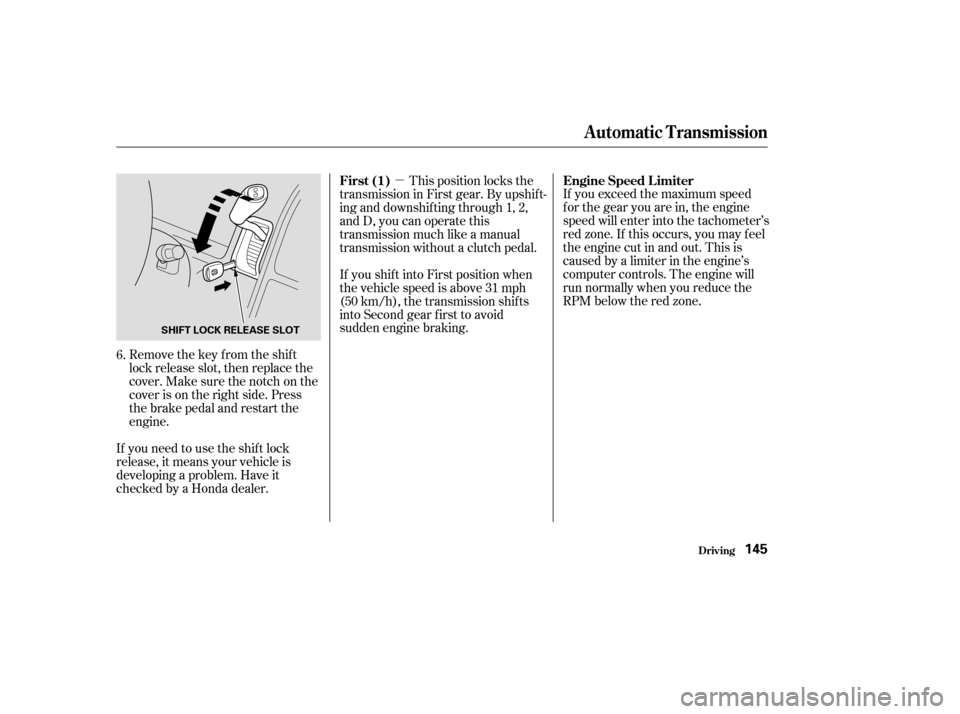Page 144 of 256
Drive in the highest gear that lets
the engine run and accelerate
smoothly. This will give you the best
f uel economy and ef f ective emis-
sions control. The f ollowing shif t
points are recommended:Normal acceleration15 mph (24 km/h)
25 mph (40 km/h)
40 mph (64 km/h)
48 mph (77 km/h)
Shif t up
1st to 2nd
2nd to 3rd 3rd to 4th4th to 5th If you exceed the maximum speed
f or the gear you are in, the engine
speed will enter into the tachometer’s
red zone. If this occurs, you may f eel
the engine cut in and out. This is
caused by a limiter in the engine’s
computer controls. The engine will
run normally when you reduce the
RPM below the red zone.
Bef ore downshif ting, make sure the
engine will not go into the
tachometer’s red zone.
Recommended Shif t Points Engine Speed L imiter
5-speed Manual T ransmission
Driving140
Page 146 of 256

�µ�µ
This position mechani-
cally locks the transmission. Use
Park whenever you are turning of f or
starting the engine. To shif t out of
Park, you must press on the brake
pedal and have your f oot of f the
accelerator pedal. If you have done all of the above and
still cannot move the lever out of
Park, see
on
page .
To avoid transmission damage, come
to a complete stop bef ore shif ting
into Park. The shif t lever must be in
Park bef ore you can remove the key
from the ignition switch.
To shift from Park
to Reverse, press the pedal, then
move the shift lever. To shif t from
Reverse to Neutral, come to a
completestop,andthenshift. Your vehicle has a reverse lockout so
you cannot accidentally shif t to
Reverse when the vehicle speed
exceeds 5 mph (8 km/h).
If you cannot shif t to Reverse when
the vehicle is stopped, press the
brake pedal and slowly shift to
Neutral, and then to Reverse.
If there is a problem in the reverse
lockout system, or your vehicle’s
battery is disconnected or goes dead,
you cannot shif t to Reverse. (Ref er
to Shif t Lock Release on page ).
144
144
To shift from:
PtoR
RtoN
NtoD Dto2 2to1
1to2
2toD
DtoN NtoR RtoP Do this:
Press the brake pedal, then
move the shift lever.
Move the lever.
Park (P) Shif t L ock Release
Reverse (R)
Automatic Transmission
Driving142
Page 147 of 256
�µ
�µ Use Neutral if you
need to restart a stalled engine, or if
it is necessary to stop brief ly with
the engine idling. Shif t to the Park
position if you need to leave your
vehicle for any reason. Press on the
brake pedal when you are moving
the shift lever from Neutral to
another gear.
Use this position f or
your normal driving. The transmis-
sion automatically selects a suitable
gear f or your speed and acceleration.
You may notice the transmission
shif ting up at higher speeds when
the engine is cold. This helps the
engine warm up f aster. TheOver-drive(O/D)ison
whenever you turn the ignition to
ON (II). Pressing the O/D switch on
the edge of the shif t lever to turn it
of f ; the O/D OFF indicator comes
on.Over-drivecanbeturnedonoroff
only when the ignition switch is in
the ON (II) position and the shif t
lever is in any position.
CONT INUED
Neutral (N)
Drive (D)Over-drive (O/D) Mode
Automatic Transmission
Driving143
OVER-DRIVE OFF INDICATOR
Page 148 of 256

�µ
WhentheOver-driveisoff,the
transmission selects only the f irst
three gears. Use it to provide engine
braking when going down a steep hill,
or keep the transmission f rom
cycling between third and f ourth
gears in stop-and-go driving.
This position locks
the transmission in second gear. It
does not downshif t to f irst gear
when you come to a stop.
Use Second gear:
For more power when climbing.
To increase engine braking when
going down steep hills.
For starting out on a slippery
surf ace or in deep snow.
To help reduce wheel spin. When driving downhill with a
trailer.
Do this if pushing on the brake pedal
and pulling the shif t lever does not
shif t the transmission out of Park: Set the Parking brake.
Make sure the ignition switch is in
the LOCK (0) position.
To release the reverse lockout,
make sure the ignition switch is in
the ACCESSORY(I) position.
Put a cloth on the edge of the shif t
lock release slot cover next to the
shif t lever. Using a key, caref ully
pry on the edge of the cover to
remove it. Insert a key into the shift lock
release slot.
To release the reverse lockout,
move the shift lever from Neutral
to Reverse, then to Park. Push down on the key and move
the shift lever out of Park to
Neutral.
1.
2.
3.
4.
5.
Second (2)
Shif t L ock Release
Automatic Transmission
Driving144
COVER
Page 149 of 256

�µIf you exceed the maximum speed
f or the gear you are in, the engine
speed will enter into the tachometer’s
red zone. If this occurs, you may f eel
the engine cut in and out. This is
caused by a limiter in the engine’s
computer controls. The engine will
run normally when you reduce the
RPM below the red zone.
This position locks the
transmission in First gear. By upshif t-
ing and downshif ting through 1, 2,
and D, you can operate this
transmission much like a manual
transmission without a clutch pedal.
If you shif t into First position when
the vehicle speed is above 31 mph
(50 km/h), the transmission shif ts
into Second gear f irst to avoid
sudden engine braking.
Remove the key from the shift
lock release slot, then replace the
cover. Make sure the notch on the
cover is on the right side. Press
the brake pedal and restart the
engine.
If you need to use the shif t lock
release, it means your vehicle is
developing a problem. Have it
checked by a Honda dealer. 6. Engine Speed L imiter
First (1)
Automatic Transmission
Driving145
SHIFT LOCK RELEASE SLOT
Page 151 of 256

Your Honda is equipped with disc
brakes at all f our wheels. A power
assist helps reduce the ef f ort needed
on the brake pedal. The ABS (on
vehicles equipped with ABS) helps
you retain steering control when
braking very hard.
Resting your f oot on the pedal keeps
the brakes applied lightly, builds up
heat, and reduces their ef f ectiveness.
It also keeps your brake lights on all
the time, conf using drivers behind
you.Constant application of the brakes
when going down a long hill builds
up heat and reduces their ef f ective-
ness. Use the engine to assist the
brakes by taking your f oot of f the
accelerator and downshif ting to a
lower gear.
Check your brakes af ter driving
through deep water. Apply the
brakes moderately to see if they f eel
normal. If not, apply them gently and
f requently until they do. Be extra
cautious and alert in your driving.
The hydraulic system that operates
the brakes has two separate circuits.
Each circuit works diagonally across
the vehicle (the lef t-f ront brake is
connected with the right-rear brake,
etc.). If one circuit should develop a
problem, you will still have braking
at two wheels.
Braking System
Driving
Braking System Design
147
Front
Page 155 of 256
The total
weight of the trailer and
everything loaded in it must not
exceed 1,500 lbs (680 kg). Towing
a load that is too heavy can
seriously af f ect your vehicle’s
handling and perf ormance. It can
also damage the engine and
drivetrain. The weight that
the tongue of a f ully-loaded trailer
puts on the hitch should be
approximately 10 percent of the
trailer weight. Too little tongue
load can make the trailer unstable
and cause it to sway. Too much
tongue load reduces f ront-tire
traction and steering control.
Towing Weight Limits
Driving
Load Limits
T otal T railer Weight: T ongue L oad:
151
Page 159 of 256

CONT INUED
The added weight, length, and
height of a trailer will af f ect your
vehicle’s handling and perf ormance,
so driving with a trailer requires
some special driving skills and
techniques.Make turns more slowly and wider
than normal. The trailer tracks a
smaller arc than your vehicle, and it
canhitorrunoversomethingthe
vehicle misses. Allow more time and
distance f or braking. Do not brake or
turn suddenly as this could cause the
trailer to jackknif e or turn over.When climbing hills, closely watch
your temperature gauge. If it nears
the red mark, turn the air
conditioning of f , reduce speed and, if
necessary, pull to the side of the
road to let the engine cool.
If the automatic transmission shif ts
f requently between 3rd and 4th
gears while going up a hill, turn of f
the Over drive (O/D) mode (see
page ).
If youmuststopwhenfacinguphill,
use the f oot brake or parking brake.
Do not try to hold the vehicle in
placebypressingontheaccelerator,
as this can cause the automatic
transmission to overheat.
Foryoursafetyandthesafetyof
others,taketimetopracticedriving
maneuvers bef ore heading f or the
open road, and f ollow the guidelines
discussed below. Drive slower than normal in all
driving situations, and obey posted
speed limits f or vehicles with trailers.
If you have an automatic
transmission, use over drive (O/D)
when towing a trailer on level roads.
Turn of f the over drive (O/D) mode
when towing a trailer in hilly terrain.
(see ‘‘
’’ in the next
column f or additional gear
inf ormation.) 143
Trailer Driving Tips
Driving
Driving Saf ely With a T railerT owing Speeds and Gears
Making T urns and Braking Driving on Hills
Driving on Hills
155